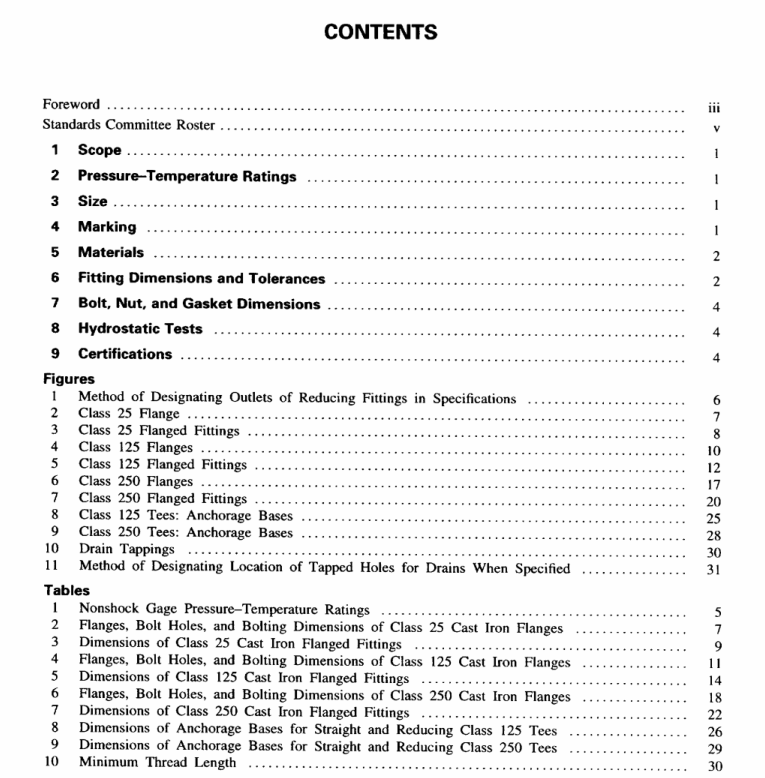ASME B16.01:1998 pdf free download CAST IRON PIPEELANGES ANDFLANGED FITTINGS lasse 25,125, and 250
6.1 Wall Thickness
tis recognized that some variations are absolutelyunavoidable in the making of patterns and castings.Equipment shall be designed to produce wall thicknessesgiven in the tables. Wall thickness at no point shallbe less than 87.5% of the thickness given in the tables.
6.2 Facing
6.2.1 Classes 25 and 125 cast iron flanges andfanged fittings shall be flat faced (i.e., without projectionor raised face) and finished in accordance with MSSSP-6.
6.2.2Class 250 flanges and flanged fittings shallhave a raised face 0.06 in. high of the diameters givenin Table 6 and finished in accordance with Mss sP-6. The raised face is included in the minimum flangethickness and center-to-face dimension.
6.3 Center-to-Face Dimensions
6.3.1 Side Outlet Fittings. Side outlet elbows,side outlet tees,and side outlet crosses shall have allopenings on intersecting centerlines. Long-radius elbowswith side outlet shall have the side outlet on the radialcenterline of the elbow.
6.3.2 EIbows
(a)The center-to-face dimensions for straight-size90deg. elbows,90 deg. long-radius elbows.45 deg.elbows,side-outlet 90 deg. elbows,and double-branchelbows are shown in Tables 3,5,and 7.
(b) Reducing 90 deg. elbows, reducing 90 deg. long-radius elbows,reducing side-outlet 90 deg. elbows,andreducing double-branch elbows shall have . the samecenter-to-face dimensions as straight-size fittings shownin Tables 3,5,and 7 corresponding to the size of thelargest opening.
(c)For 90 deg. long-radius elbows with side outlet,the center-to-face dimensions of the side outlet shallbe the same as dimension A in Tables 3,5,and 7 fora straight-size 90 deg. elbow corresponding to the sizeof the largest opening.
(d)Special-degree elbows ranging from 1 deg. to45 deg.,inclusive, shall have the same center-to-facedimensions as those for 45 deg. elbows; those over 45deg. and up to 90 deg.,inclusive, shall have the samecenter-to-face dimensions as those for 90 deg. elbows.The angle designation of an elbow is the angle betweenthe flange faces.
6.3.3 Tees,Crosses, and Laterals
(a)The center-to-face dimensions for straight-sizetees and crosses, with or without side outlet, and lateralsare shown in Tables 3,5,and 7.
(b)Reducing tees and reducing crosses,with orwithout sidc outlct.and reducing laterals,NPS 16 andsmaller,shall have the same center-to-face dimensionsas straight-size fittings shown in Tables 3,5,and 7corresponding to the size of the largest opening. ForNPs i8 and larger. if the outlet of a reducing tee; thebranch of a reducing lateral; or the largest outlet of areducing side outlet tee,reducing cross,and reducingside outlet cross is the same size or smaller than givenin Tables 3,5,and 7 (short body pattern), the center-to-face dimensions shown in these Tables shall be used.If a branch or any outlet is larger than shown in Tables3,5,and 7. the center-to-face dimensions shall be thesame as for the straight-size fitting shown in Tables3,5,and 7 corresponding to the size of the largestopening. Tees,crosses,and laterals,reducing on therun only, shall have the same center-to-face dimensionsas straight-size fittings shown inTables 3,5,and7corresponding to the size of the largest opening.
(c) Tees reducing on both runs are gencrally knownas bull-headtees and have the same center-to-facedimensions as straight-size fittings corresponding to thesize of the outlet.
6.3.4 True Ys. Center-to-face dimensions forstraight-size true Ys are shown in Tables 5 and 7.Reducing sizes are considered special and should bemade to suit conditions.
6.3.5 Reducers and Eccentric Reducers. Theface-to-face dimensions for all reductions of reducersand eccentric reducers shall be the same as given inTables 5 and 7 for the largest opening.
6.4 Center-to-Face Tolerances
The following tolerances shall be permitted on allcenter-to-contact surface dimensions of fittings: Toler-ances for contact surface-to-contact surface dimensionsshall be twice those given below. The largest openingin the fitting governs the tolerance to be applied toall openings.
ASME B16.01:1998 pdf free download
